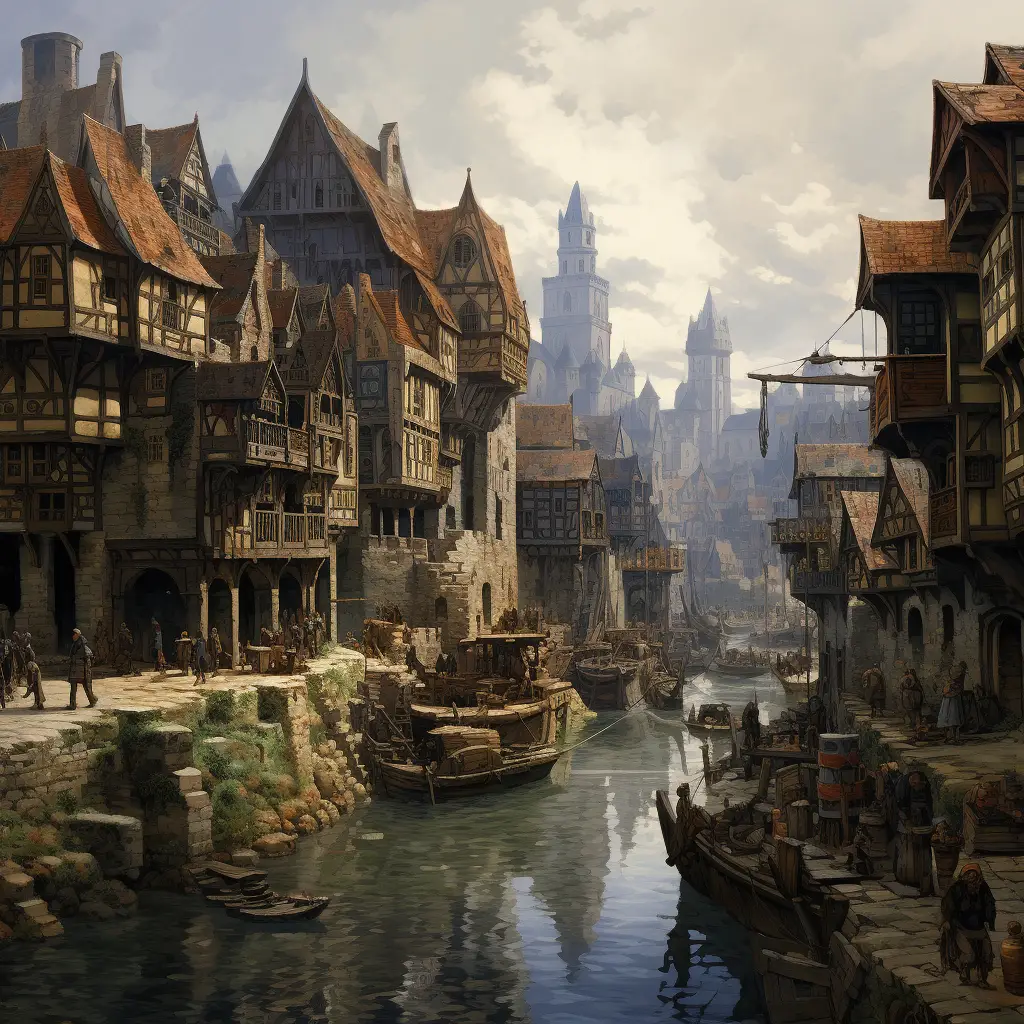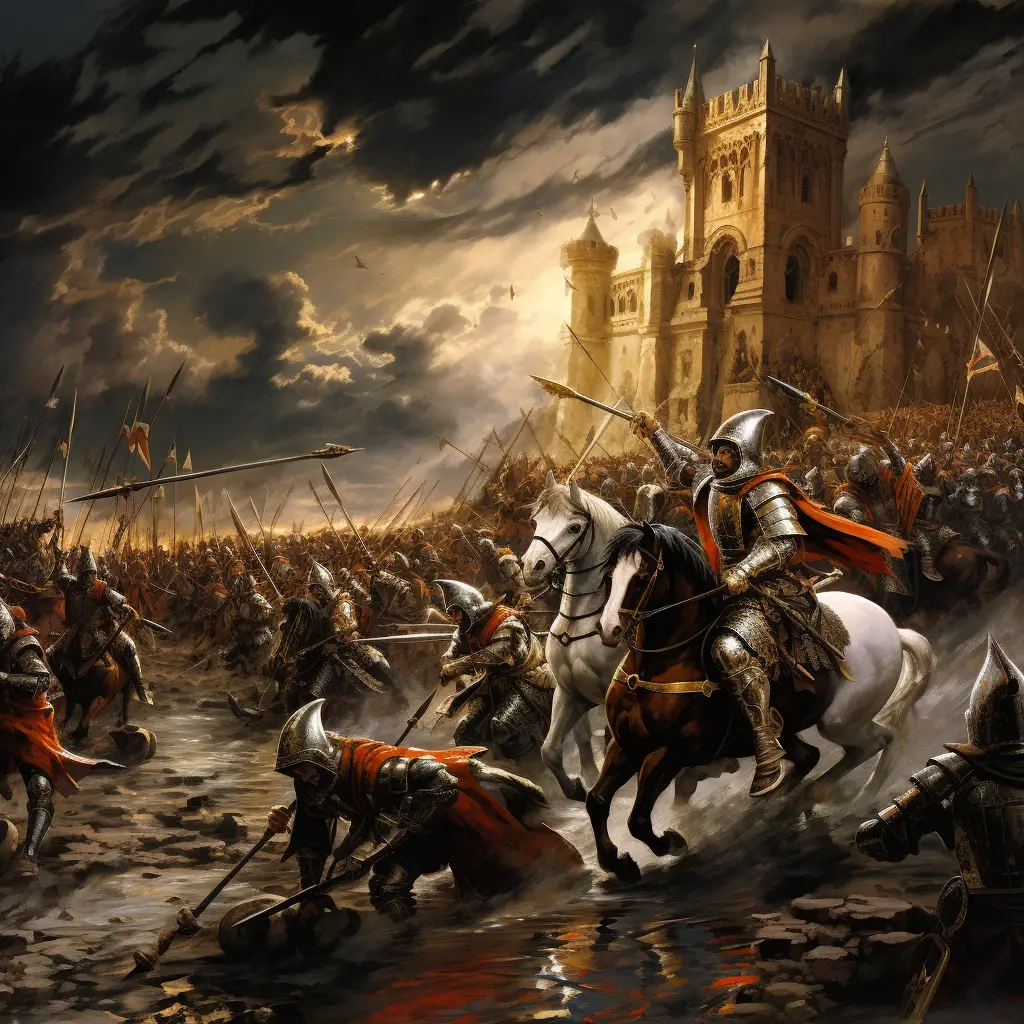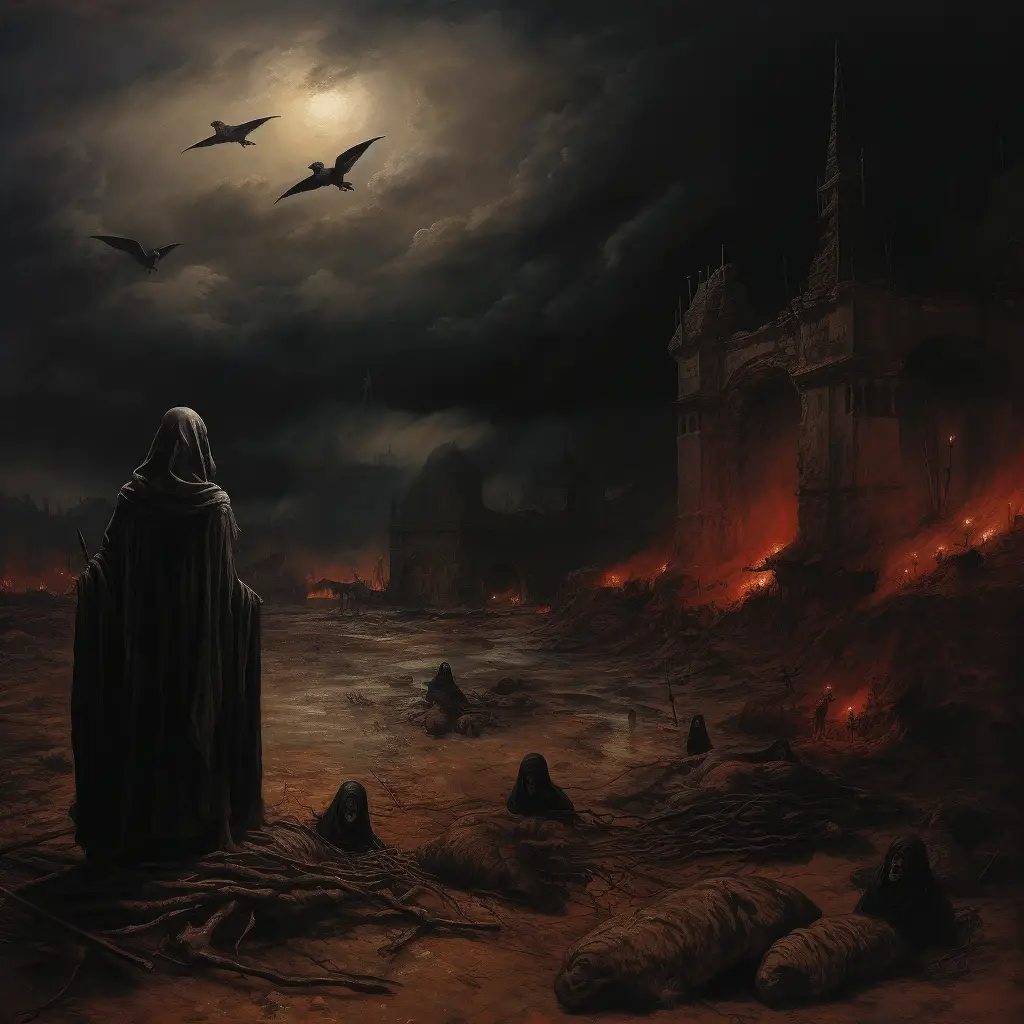High Middle Ages
At this point, we’ve talked about the fall of the Roman Empire, the rise of the Catholic Church, and the practices of feudalism and manorialism that began after a long series of invasions throughout Europe in the ninth and tenth centuries, so let’s move on to the period of time known as the High Middle Ages (1000-1300).
The High Middle Ages, which spanned from the 11th to the 13th century, marked a period of significant cultural, economic, and political development in Europe. During this time, feudalism was the dominant social and economic system, with powerful monarchs and nobles exerting control over vast territories.
The growth of cities and the rise of trade also played a crucial role in shaping this era. Notable events include the Crusades, the emergence of universities, and the construction of magnificent Gothic cathedrals. Overall, the High Middle Ages laid the foundation for the Renaissance and the modern world.

High Middle Ages Facts for Kids
- The High Middle Ages lasted from 1000 to 1300 AD.
- It was a time of growth and expansion in Europe.
- The Catholic Church became very powerful.
- Knights followed a code of conduct called chivalry.
- Feudalism was the main social system.
- William the Conqueror led the Norman Conquest in 1066.
- The Crusades were big religious wars during this time.
- Gothic architecture, with tall, pointed buildings, began.
- Universities like Oxford and Paris were founded.
- Medieval literature, like “Canterbury Tales”, was written.
Early 13th Century
The early 13th century considered the zenith of the High Middle Ages, was marked by flourishing culture, territorial expansion, and socio-religious transformation in Europe. The Papacy reached its peak in power and influence, launching the Fourth Crusade. The kingdoms of England, France, and the Holy Roman Empire experienced significant developments, while the Iberian Peninsula saw the advancement of the Reconquista. Universities in Bologna, Oxford, and Paris thrived, promoting intellectual pursuits. This period embodies the High Middle Ages’ spirit of cultural progress and political complexity.
Northern Europe
The High Middle Ages in Northern Europe was a period marked by dynamic changes and growth. The region experienced the Christianization of Scandinavian kingdoms and the intensification of the Norse sagas. Trading networks, such as the Hanseatic League, emerged, encouraging economic and cultural exchange across the Baltic and North Sea. Additionally, the architecture evolved from Romanesque to the early stages of Gothic. The Norman conquests extended to areas like Ireland and Scotland. Overall, this period signaled a closer integration of Northern Europe into the broader European cultural and economic sphere.
Medieval Europe
The High Middle Ages (1000-1300 AD) was a period of significant evolution and expansion in Medieval Europe. After centuries of turmoil following the fall of the Western Roman Empire, Europe began to stabilize, with the development of centralized monarchies, the refinement of feudalism, and the growth of cities. The Catholic Church became an influential institution, both spiritually and politically. The Crusades, chivalry, and Gothic architecture are hallmarks of this era. Furthermore, advancements in agriculture, technology, and trade laid the foundation for the prosperity of the late Middle Ages.
Western Europe
The High Middle Ages was a transformative era in Western Europe, witnessing significant advancements in various spheres of life. With the establishment of centralized monarchies, regions like France and England began to solidify their territorial boundaries. The influence of the Catholic Church grew enormously, and the feudal system evolved as the predominant social structure. The period was marked by iconic architectural achievements in the Gothic style, the flourishing of literature, and the advent of the Crusades. The era laid the groundwork for Western Europe’s development into the modern age.
Late Middle Ages
The High Middle Ages (1000-1300 AD) set significant socio-political and cultural foundations that directly impacted the Late Middle Ages (1300-1500 AD). The structures and institutions solidified during the High Middle Ages, such as feudalism, the Catholic Church’s role, and the norms of knighthood, were tested during the Late Middle Ages by events like the Black Death, the Hundred Years’ War, and the Great Schism. While the High Middle Ages was a time of consolidation and growth, the Late Middle Ages was characterized by upheaval and transition, marking the end of medieval society and the dawn of the Renaissance.
High Medieval Period
The terms “High Middle Ages” and “High Medieval Period” often refer to the same historical timeframe, spanning from approximately the eleventh century to the thirteenth century. This era was marked by substantial growth in population, trade, and intellectual activity in Europe. Key developments included the spread of Christianity throughout Europe, the rise of feudalism, and the dominance of the Catholic Church. The period also saw important cultural and political events such as the Crusades, the development of Gothic architecture, and the codification of chivalric codes.
Independent City States
During the High Middle Ages, the concept of independent city-states, particularly in regions like Italy, became prominent. These city-states, including famous ones like Venice, Genoa, and Florence, were often republics run by merchant guilds or wealthy families. Their independence was attributed to their economic strength, largely derived from trade. These city-states played crucial roles in the economic and cultural developments of the period, including the revival of commerce and the emergence of the Renaissance, underscoring the intricate political landscape of the High Middle Ages.
Christian Heresies
The High Middle Ages was a period when the Catholic Church sought to consolidate its spiritual authority, leading to the identification and suppression of Christian heresies. Notable heretical movements included the Cathars and Waldensians, whose beliefs diverged from orthodox doctrine. The Church, often with the support of secular authorities, responded with measures ranging from preaching and debates to the establishment of the Inquisition. These confrontations with heresy highlighted the Church’s dominant role and the tensions inherent in religious and intellectual life during this period.
Feudalism
The High Middle Ages (1000-1300 AD) was a period characterized by the expansion and refinement of the Feudal system. This social and political structure was defined by hierarchical relationships and obligations between lords, vassals, and serfs. Lords granted land, known as fiefs, to vassals in return for military service. Simultaneously, serfs worked the land and provided goods and services to their respective lords. The stability that Feudalism provided facilitated cultural and intellectual growth, marking this era as a significant time in European history.
The Crusades

The High Middle Ages was a crucial period for the Crusades, religious wars initiated by the Christians of Western Europe against the Muslim powers in the Middle East. Launched in 1095, the First Crusade was a direct response to appeals from Byzantine Emperors seeking aid against Turkish expansion. These wars brought about significant cultural exchange and economic shifts, as they expanded the reach of European traders to the East. However, the Crusades also amplified religious tensions, marking an era of prolonged conflict in the region.
The Rise of the Catholic Church
During the High Middle Ages, the Catholic Church rose to unprecedented prominence, effectively becoming the central institution of Western Europe. It not only wielded spiritual authority but also exercised significant temporal power, influencing politics, social structure, and culture. The Church enforced canon law, collected tithes, and played a crucial role in the education and preservation of knowledge. Simultaneously, it facilitated the Crusades and the expansion of monastic orders. This period marked the zenith of Papal power, underlining the Church’s significant role in shaping medieval society.
The Holy Roman Empire
The Holy Roman Empire, a multi-ethnic complex of territories in central Europe, was a pivotal political entity during the High Middle Ages. It saw the reign of notable emperors such as Otto I and Frederick Barbarossa, who endeavored to consolidate imperial authority. Their efforts often led to conflicts with the rising power of the Papacy, epitomized in the Investiture Controversy. Despite internal divisions and external threats, the Empire fostered significant cultural and economic development, symbolizing the intricate balance of power during this era.
Chivalry and Knighthood
During the High Middle Ages, the concepts of chivalry and knighthood took shape and deeply influenced the social and cultural fabric of the time. Chivalry, a code of conduct associated with the medieval institution of knighthood, promoted virtues like honor, courage, justice, and readiness to assist the weak. Knights, seen as the epitome of chivalry, underwent rigorous training and participated in tournaments that showcased their martial prowess. This era also saw the proliferation of Arthurian literature, further romanticizing the ideals of chivalry and knighthood.
The Norman Conquest
The High Middle Ages was significantly shaped by the Norman Conquest of England in 1066. This momentous event led by William the Conqueror not only shifted the ruling dynasty of England but also catalyzed profound social and cultural transformations. It resulted in the imposition of Norman culture, the reorganization of the English Church, and the introduction of feudalism. Additionally, the Conquest induced changes in the English language with the infusion of Norman French, significantly influencing the development of Modern English.
Gothic Architecture
The High Middle Ages witnessed the advent of Gothic architecture, a style that revolutionized the landscape of European cities. Originating in France around the mid-12th century, Gothic architecture is characterized by pointed arches, ribbed vaults, and flying buttresses. These innovations allowed structures to reach new heights and accommodated the inclusion of larger windows, resulting in luminous interiors adorned with stained glass. Iconic buildings like Notre Dame Cathedral and Chartres Cathedral epitomize this architectural trend, showcasing the era’s advancements in artistry and engineering.
The Hundred Years’ War
While the High Middle Ages culminated around 1300, its influence extended into subsequent periods, such as during the Hundred Years’ War (1337-1453). This prolonged conflict between England and France was rooted in disputes over the French throne and territories, issues tied to the complex feudal relations established during the High Middle Ages. The war significantly shaped both nations, contributing to the rise of national consciousness, changes in military technology and tactics, and shifting the balance of power in Western Europe.
Medieval Literature
The High Middle Ages was a vibrant era for Medieval literature, marked by the proliferation of vernacular languages and the creation of enduring literary genres. Renowned works like Dante’s “Divine Comedy”, Chaucer’s “Canterbury Tales”, and the Arthurian legends contributed to the rich tapestry of this era’s literature. These texts not only reflected the prevailing societal norms, religious beliefs, and historical events, but also played a vital role in shaping European thought and culture, leaving an indelible mark on the course of Western literature.
The Black Death

While technically occurring after the High Middle Ages, the Black Death (1347-1351) was a devastating pandemic that fundamentally transformed Europe, a continent still shaped by medieval structures. The bacterium Yersinia pestis caused the disease, which was likely spread by fleas on black rats. With an estimated mortality rate of 30-60% of Europe’s population, the Black Death had profound socio-economic impacts. It led to labor shortages, challenging the existing feudal system, and catalyzed shifts in religious, cultural, and medical practices, marking the end of an era and the beginning of significant change.
A Warmer World: How the High Middle Ages Improved Life
Life was picking up pace and improving during the High Middle Ages, in part because the climate of Europe got a little warmer. Areas that could not be farmed in the Early Middle Ages were suddenly new places to grow food and raise animals, and with more farming came more food. This meant that people were healthier than before, and they could store any extra supplies they had for later seasons.
Cities on the Rise: The Busy World of the High Middle Ages
The population grew and grew, and eventually, new cities were built and small towns expanded to become cities. In fact, cities seemed to constantly be in a state of construction, because as soon as they had grown large enough to fit the people living there, new people arrived. Old city walls were either kept or torn down. Cities of the High Middle Ages would appear very odd and crowded to us, but keep in mind, this was a time before a lot of thought and planning went into creating cities. The most important thing was giving people a place to live where they would be protected.
The Busy Center: Cathedrals, Markets, and Learning in the Middle Ages
In the center of the city was the cathedral or church, which was always the highest building in any town or city of the Middle Ages. Near the church was the marketplace, where people sold their handmade goods or produce and gathered together to work and talk.
Education became even more important in the High Middle Ages. Previously the Catholic Church had been the only true place of learning, but universities began to grow in larger cities, attracting the attention of young nobles who wanted to study new ideas about the world around them. Of course, this meant that towns became even more crowded than before and a bit noisier. Even in the Middle Ages, students would be students.
Cultural Fusion: William the Conqueror and Anglo-Norman Heritage
Rulers were becoming more important, too. In 1066, William the Conqueror (originally from France) became the King of England. He attempted to bring together the Anglo-Saxons of the British Isles and the Normans of France in one united group of people, while still paying attention to the traditions of both cultures. Eventually, Norman culture had such an impact on the Anglo-Saxons that a new culture was born: Anglo-Norman. French (the language of the Normans) became the common language spoken by nobles, Latin was still used by the Church, and everyone else spoke Old English, a very different form of English than we speak today.
Changing Powers: William, King John, and the Magna Carta
Changes made to the practice of feudalism during William’s rule shifted who had the most power (in this case, the king and not simply lords), and his style of government influenced how the British Isles were governed for centuries afterward, including the creation of a very early form of Parliament, which eventually divided in the fourteenth century into the House of Lords and the House of Commons you might be familiar with from today’s times.
Many kings came after William, not simply in England but across Europe as well. Each king had his own changes to make to how things were run—sometimes for the better and sometimes for the worse. One king in particular—King John, who took the English throne in 1199—made his people (and the clergy) so angry over his demands for more taxes and his harsh punishments that the people of England responded by creating a document known as the Magna Carta, which laid out the basic rights of the people. No more taxes for funding wars, the people of England said, until the document had been signed. King John reluctantly signed their document, and history was made.
Powerful Church and Daring Knights
Meanwhile, the Church was gaining a good amount of power, and we cannot talk about the High Middle Ages without noting that during this period, the famous Crusades began, sending knights and pilgrims to Jerusalem to take over the Holy Land. However, this topic is worth its own section, and for now, we’ll stick to the basics of the High Middle Ages.
In Summary
The High Middle Ages saw many changes: more food, more people, and more trade with other cultures than ever before. New areas of the world were being explored, and great explorers such as Marco Polo were making names for themselves.
Europeans were divided into separately-ruled areas that we recognize today, such as Portugal, Spain, France, England, and Italy (along with other nation-states), but there was still warring over lands and territories. Feudalism was becoming a thing of the past, and people were moving toward a more city-focused lifestyle, with shops and shop signs, markets and goods, and even guilds for learning new trades. Life was certainly very different than it had been in the Early Middle Ages.



